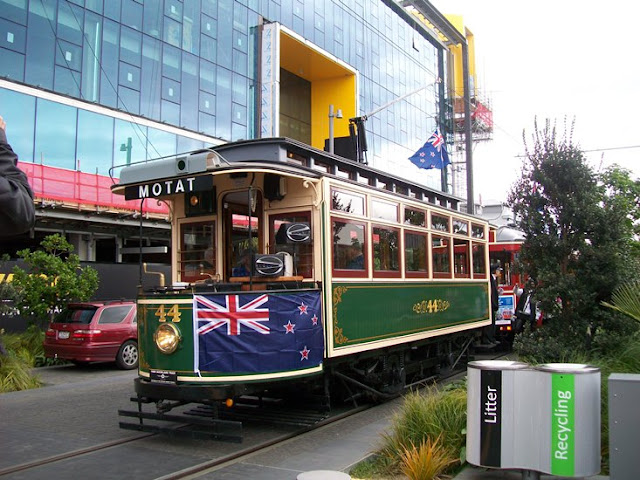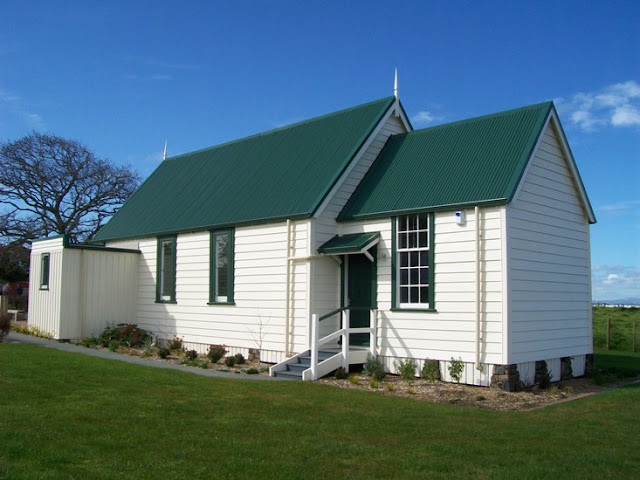Auckland Weekly News 27 November 1902, AWNS-19021127-12-2, Sir George Grey Special Collections, Auckland Library
Mr P M Hansen expects to arrange the ceremonial opening of the electric tram service on Monday, l7th November. The trial runs are expected to be completed by November 10th, but the whole of the ensuing week is rendered unavailable for the formal ceremony for the following reasons: Monday, Nov10, public holiday; Tuesday, engineers’ preparations prevented by the previous day's holiday; Wednesday, race day; Thursday, City Council meeting would clash with the evening function; Friday and Saturday are Agricultural Show days. Therefore Monday, November 17, was chosen. Invitations will be issued early next month. At 12.30 on the Monday His Worship will start the machinery at the power station, and then Sir John Logan Campbell will start the first car from Lower Queen-street. To this will be attached two other cars carrying guests, and the course will be up Queen-street and Wellesley-street and on to the Choral Hall, where lunch will be provided. The regular service to Ponsonby will begin, if all goes well, on the following day.
Auckland Star 22 October 1902
A little over fifteen months ago, on August 1, 1901, the first ground was broken in connection with the laying of the rails for the Auckland Electric Tramways Company—to-day saw the inauguration of the service. During the comparatively short interval the large sum of £120,000 has been spent locally in the laying of rails, the fixing of posts and wires, the erection of the power house and depots, etc. To this must be added the heavy sums spent in England and America for cars rails, posts, engines etc., the total being sufficient to absorb the company's capital of £300,000. The lines laid measure about 20 miles, mostly double track; in single track there being about 34 miles of lines laid, all of this having been done in a little over a year, while the power-house and the depots have been put up in considerably less time.Several delays, altogether unavoidable by the company, have occurred, preventing the starting of the cars on the date fixed in the Order-in-Council giving authority for the service, June 1. A railway strike in America delayed the arrival of the rails, the machinery for the power station was delayed by lengthened trips of the New York steamers, and the wet weather hindered the work of laying the rails, so that nearly three months of unavoidable delay occurred. The proceedings in connection with the inauguration of the service opened at the power house in Albert-street at half-past twelve, when a. large crowd of invited guests assembled within the building, examining the generator, the three large dynamos, and the switchboard from which the currents are worked …
After the company had inspected the machinery contained within the power house Mr Paul M Hansen, attorney for the company, accompanied by Mr Alfred Kidd (Mayor), Sir John Logan Campbell, Mr H Wilson (town clerk), Mr James Stewart, C.E., Mr Carey, electrical engineer for the company, and Mr Turner, attorney for Messrs J. G. White and Company, ascended the platform from which the switches are worked, and after a selection had been played by Hunter's Garrison Band the generator was started going. A few minutes after Mr Hansen, on behalf of his company, requested Mr Kidd to turn on the electrical current for the line. Mr Kidd then depressed the lever by means of which the current was switched to the line amid loud applause. Addressing the company, Mr Kidd said that nothing during the term of his office had given him greater pleasure than to assist in opening that important work. On August 1st of last year he had the pleasure of turning the first stone in connection with the work, and they would remember that the day being gloomy and rainy. Mr Hansen remarked that he thought it was the angels weeping for gladness because the work had been started. When he (Mr Kidd) awoke this morning and found that it was raining again he could not help thinking that the angels were weeping for joy that the work was finished.The work was one of the largest undertakings carried out in New Zealand in connection with a private company or a municipality, and would do an immense deal of good to the city and its surroundings. (Applause.) When they remembered the serious troubles which occurred during the execution of the work —bad weather, the winter having been the worst for continuous rain that he remembered, and all the work being outside, the disaster to the power house by the falling of a girder, the fire which destroyed a portion of the materials, and the strikes in America—they would understand that the work had been delayed by no fault of the company. There was a little delay in the formation of the company, but both the company and the contractors had done all in their power to bring the matter to a successful issue in the time that was arranged. They would all agree that the delays which had occurred were unavoidable, because the company could not foresee them and provide against them. The work had not been skipped to save time, but had been done in very satisfactorily…
The work would cost nearly £450,000 and would do an enormous amount of good to the city and suburbs. About £130,000 had been spent locally, and already a large amount of good must have been done to the city by the expenditure of this large amount of money. The good that would issue from the cars would be inestimable. Workmen would be able to leave the crowded parts in the city and living as far away as Onehunga would be able to reach town in almost the same time as from the Three Lamps at present. They would all feel proud to think that Auckland was the first city in New Zealand to undertake that great work and bring it to a successful conclusion throughout the whole of the city and suburbs …The assembly then left the power house, and proceeded to the foot of Queen-street, opposite the Tramway Company's offices, where six cars were waiting to convey them to the Choral Hall, where luncheon was provided for the guests. Three of the cars were despatched from the Ponsonby depot early in the morning, and remained on the roadway until the party was ready to start. All the morning they were surrounded by crowds of people, and their attractive appearance, comfortable seating accommodation, and general elegance, were the subject of much favourable comment … it is only necessary to add that on the street they look very attractive, the dark red panels contrasting well with the bright yellow sides and tops. The cars are not disfigured externally by advertisements, the number of the car and the monogram of the company being all which appears on the outside. A crowd numbering several thousand people gathered round the cars before the hour at which they were timed to start, 1.15 p.m. When all the cars were filled with guests, Mr Hansen stepped to the front of the first car, and addressing Sir John Logan Campbell, said that on behalf of his company he had the honour to ask Sir John to start the first electric tram car in this city. Knowing that to drive an electric car, or any other passenger vehicle in the city without a license was illegal, and further knowing that Sir John would not do anything against the law, he had taken the liberty to take out a motorman's license for Sir John, which he would ask the town clerk (Mr H. Wilson) to present. Mr Wilson then presented the license, which was handsomely bound in red leather, with silver corners and clasps.
At the call of Mr Hansen three hearty cheers were given for Sir John Campbell, followed by three for Mr Hansen, called for by Sir John, and three for the Electric Tramways Company. Sir John, accompanied by Messrs Hansen, Kidd, Wilson and Carey then stepped aboard the platform of the car, and Sir John turned the lever which made the connection between wire and rail, thus starting the car. As he did so he said: "Success to the Auckland Tramways Company. May its cars never cease to run in Auckland." The car then moved off up Queen-street, amidst the cheers of the crowd, and followed by the other five ran up to the Choral Hall. The cars were insufficient to carry all the invited guests, and had to make a second trip. The passengers were all loud in their praises of the quiet, steady manner in which the cars ran, and of the comfort of the seating accommodation.
Auckland Star 17 November 1902
I shouldn't be too critical of the re-enactment yesterday of the first electric tram put on by MOTAT, the Auckland Dockline Trams, Auckland Council and a host of others for this year's Heritage Festival. The emphasis this year is on commemorating the centenary of Sir John Logan Campbell's death, so the focus wasn't so much on the tram history as it was on the chap with the long white beard given the controls to drive the electric tram.
Still, it would have been nice to see the display that the invited dignitaries got to see in the trambarn -- some pictures online at the Facebook page for the Waitemata Local Board. They've referred to Sir JLC as "Mayor of Auckland". Not really accurate for the first tram inauguration -- as seen from the passages quoted above, that was Alfred Kidd by the time November 1902 rolled around.
No. 44 only dates from 1906, as well. It wasn't there at the inauguration, or even in existence. MOTAT do have a tram dating from 1902, and part of the first shipment to come from England where it was built -- No. 11. But, unfortunately, when it was restored at MOTAT, they brought it back only to its 1912 configuration: the period after the open-cab days. So, it would have been period-correct, but not in looks.
That said, while No. 44 looks the part structurally, it doesn't in terms of livery. Also as seen from the Auckland Star report -- the 1902 livery for the six ceremonial trams was red and yellow. I'm fairly certain the Weekly News image also shows a Stars and Stripes flag (oddly) fluttering from the roof.
Where, also, was the honorary motorman's license handed to Sir JLC, "handsomely bound in red leather, with silver corners and clasps" ? That would have been a nice touch.
Still, I think it was worth the dash into the city to view the re-enactment at 1.30, listen to the speeches, take photos for the blog, then scurry on to Dominion Road in time for the 3.00 pm video launch of The Making of Albert-Eden. There were a few anxious moments, connecting from Wynyard Quarter to Queen Street via the Red Link Bus, then travelling on via the 267 Lynfield bus from Wellesley Street but -- Auckland public transport of 2012, you didn't let me down. Nice one.



























































